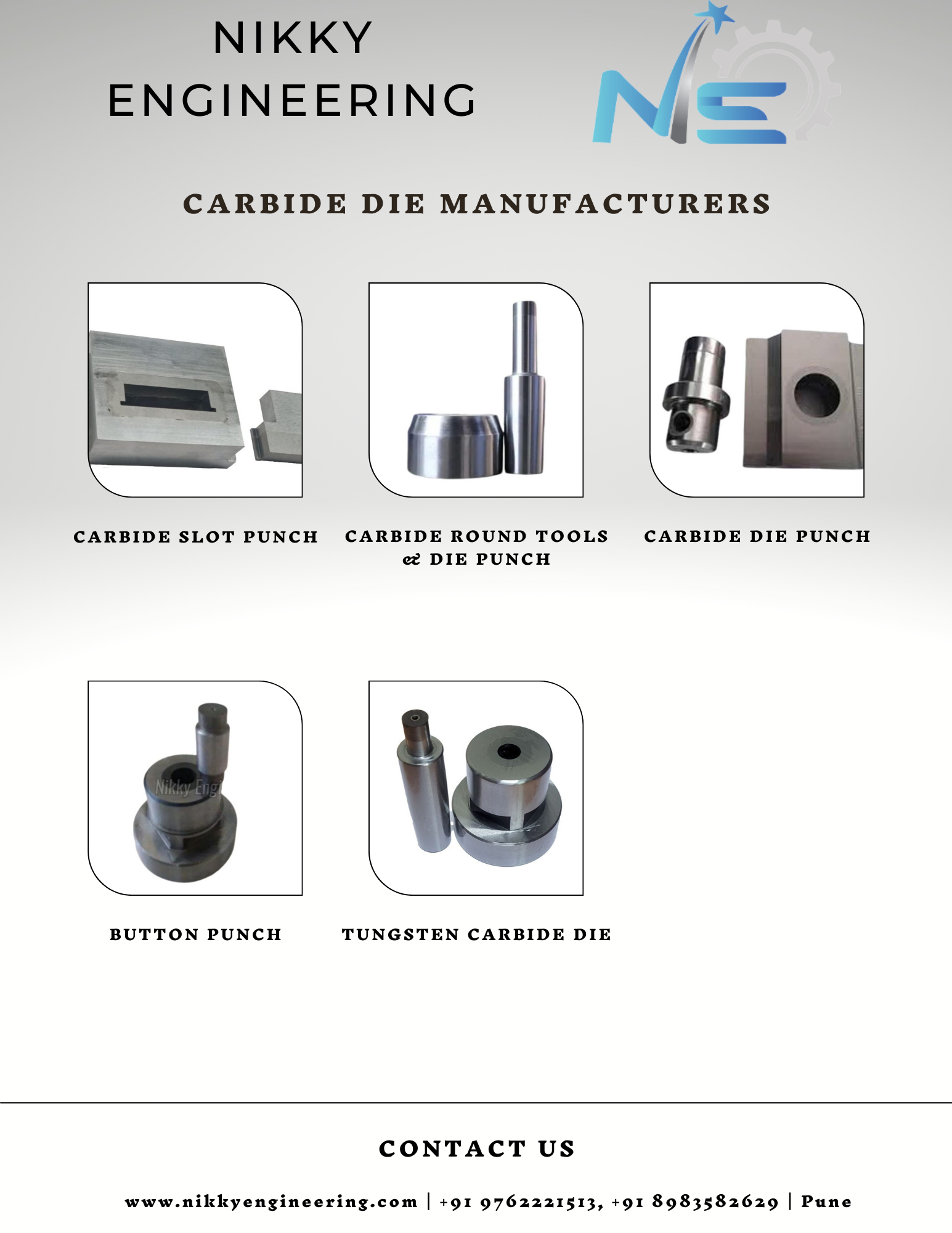Carbide Die Manufacturers
We are carbide die manufacturers in India. We Nikky engineering, is one of the prominent organizations that are engaged in the manufacturing and supplying of different types of tools and punches. A carbide die is a tool used in the manufacturing industry for shaping or forming materials such as metal, plastic, and ceramics. It is typically made of tungsten carbide, which is a very hard and durable material that can withstand high pressures and temperatures.
Carbide dies are used in a variety of applications, including wire drawing, extrusion, and cold heading. They are often used in the production of fasteners such as screws, bolts, and nuts, as well as in the manufacturing of automotive and aerospace components.
The process of using a carbide die involves forcing the material through the die under pressure, which shapes it into the desired form. The shape of the die determines the final shape of the material, so carbide dies are precision-engineered to ensure consistent and accurate results.
Types of carbide dies
There are several types of carbide dies used in manufacturing processes, including:
- Round dies: Round carbide dies are used in wire drawing processes to reduce the diameter of wire or cable. They are typically made with a cylindrical shape and are used to form materials into round cross sections.
- Shaped dies: Shaped carbide dies are used to form materials into non-round shapes, such as hexagons, squares, or rectangles. They are commonly used in the cold heading and extrusion processes to produce components with specific shapes and dimensions.
- Extrusion dies: Extrusion carbide dies are used to shape materials, such as plastics or metals, into specific forms. They are typically designed with a specific profile or shape and are used to produce products with consistent cross-sections.
- Drawing dies: Drawing carbide dies are used in wire drawing processes to reduce the diameter of wire or cable. They are designed to pull the material through the die, which reduces its diameter and shapes it into the desired form.
- Swaging dies: Swaging carbide dies are used to compress and shape metal tubes or wires into specific forms. They are commonly used in the production of precision components, such as medical devices or aerospace components.
Overall, the type of carbide die used in a manufacturing process depends on the specific application and the desired outcome. The shape and design of the die are critical factors in determining the final shape and dimensions of the product.
Benefits of carbide die:
There are several benefits of using carbide dies in manufacturing processes, including:
- High durability: Carbide dies are made from tungsten carbide, which is an incredibly hard and durable material. This means that carbide dies can withstand high levels of wear and tear, which makes them ideal for high-volume production processes.
- Resistance to wear and corrosion: Carbide dies are highly resistant to wear, corrosion, and abrasion. This means that they can maintain their shape and accuracy even after extended periods of use.
- Improved dimensional accuracy: Carbide dies are engineered to precise tolerances, which ensures consistent and accurate results. This level of precision is difficult to achieve with other materials, which can lead to inconsistencies in the final product.
- Reduced downtime: Because carbide dies are so durable and resistant to wear, they require less maintenance and replacement than other types of dies. This means that manufacturing processes can run for longer periods of time without interruption, reducing downtime and improving overall efficiency.
- Increased productivity: The high durability and dimensional accuracy of carbide dies can lead to increased productivity and improved quality control. This can ultimately result in cost savings and improved customer satisfaction.
Applications:
Carbide dies are used in a wide range of manufacturing applications, including:
- Wire drawing: Carbide dies are commonly used in wire drawing processes, which involve pulling wire or other materials through a die to reduce its diameter. This is a common process in the production of electrical wires, cables, and other small-diameter products.
- Extrusion: Carbide dies are used in extrusion processes, which involve forcing materials through a die to shape them into a specific form. This is a common process in the production of plastic and metal products, such as pipes, tubing, and profiles.
- Cold heading: Carbide dies are used in cold heading processes, which involve forming metal blanks into specific shapes by applying pressure to them. This is a common process in the production of fasteners such as bolts, screws, and nuts.
- Powder compaction: Carbide dies are used in powder compaction processes, which involve compressing powdered materials into a specific shape or form. This is a common process in the production of ceramics, electronics, and other materials.
- Swaging: Carbide dies are used in swaging processes, which involve shaping metal tubes or wires by compressing them with a die. This is a common process in the production of medical devices, aerospace components, and other precision products.
Overall, carbide dies are widely used in manufacturing processes that require high levels of precision, durability, and accuracy.
If you require a carbide die, contact Nikky Engineering for more details!

